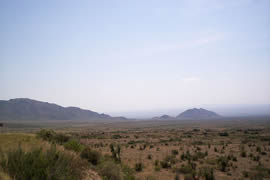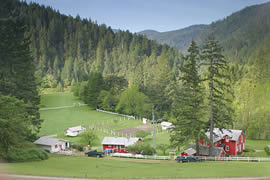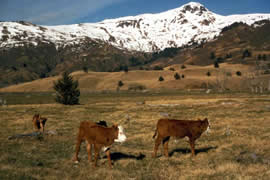Reaching for Quivira:
The New Mexico Coalition
By Brook & Gaurav Bhagat

Quivira is a Spanish word that is not easy to translate: “an elusive golden dream... fabulous realm just beyond the horizon... unknown territory beyond the frontier." The Quivira Coalition, based in Santa Fe, New Mexico, began as an alliance between two environmentalists and a rancher; in the last eight years, it has snowballed into an environmental force to be reckoned with, and is as difficult to squeeze into easy definitions and categories as its name.
The basic philosophy of the group is that the best thing for environmentalists, ranchers, and the environment itself is to stop fighting long enough to see the ranching issue in a new way. Hard-core environmentalists want to stop ranching altogether; hard-core ranchers want to keep on ranching the way their forefathers have done it for a century. This we know destroys the ecosystem, and eventually their own profits; but putting ranchers out of business often results in the land being resold to developers and turned into condominiums, parking lots or shopping malls, which is the last thing either side wants.
Quivira’s task is to try to get both parties to see what they have in common, and work together. Observation and an ever-deepening understanding of grazeland ecosystems can and has led to new ranching methods that are less and less harmful, and that even help heal the environment from the ranching wounds of the past. In their own words, “It is a nonprofit organization dedicated to bringing ranchers, environmentalists, public land managers, and other members of the public together and demonstrating to them that ecologically healthy rangeland and economically robust ranches can be compatible. Our mission is to define the core issues of the grazing conflict and to articulate a new position based on common interests and common sense. We call this position the New Ranch."
Jim Winder, who owns the Beck Land and Cattle Company, is one of the co-founders. He points out the radical reality that we humans have doubled since 1950 and will reach the mark again near 2050. The question is how to keep our lands healthy enough to provide that food to enormous number of fellow humans we will have by this time.
Enlightened mystic Osho said, “if you are violent and your food is vegetarian, then your violence will have to find some other way of expression. It is natural, because eating non-vegetarian food gives release to your violence." Humanity has now plenty of violence seeking release-- as well as the habit and fondness for the taste of meat.
The land needed to produce a one-year food supply for a person who has to support a meat-eating habit is 3.25 acres. For a pure vegetarian, 1/6 acre. Not to mention the fact that producing one pound of meat requires about 2,500 gallons of water, which is 12 times more than the requirements of a pure vegetarian.
Lester Brown of the Overseas Development Council has estimated that if Americans would reduce their consumption of meat by only 10%, the amount of grain wasted on animal feed that could be diverted for direct human consumption would be sufficient to adequately feed every one of the 60 million people who die from hunger each year.
To consume more primary foods and less secondary foods, i.e., more vegetation than animals, is healthier for our bodies as well as our planet; but this is another issue, and as long as there are customers for meat, ranching will be of concern to the environment.
Courtney White is the executive director and one of the co-founders of the Quivira Coalition. A realization at age 16 changed his life, and in turn, his influence and that of the Coalition has changed many lives now. In his words, after taking a backpacking tour of Yellowstone and other National Parks with his math teacher and some chums, “it was not just environment that turned my head, but the whole idea of the American West -- its beauty, space, people, and diversity. I more or less decided right then and there to devote my life to exploring the region, understanding it, and assisting it in some way."
When the Quivira Coalition was formed in 1997, the environment in New Mexico was in
 desperate need of assistance. 400 years of ranching with the techniques acquired from more temperate regions had led this semi-arid region to a state of disappearing grasslands with excessive trees and shrubs. Recurrent drought and the ranchers’ suppression of natural fires further disturbed the ecosystem. As soon as cattle crowded into the remaining meadows, savannas and riparian areas, the problem rose to its peak.
desperate need of assistance. 400 years of ranching with the techniques acquired from more temperate regions had led this semi-arid region to a state of disappearing grasslands with excessive trees and shrubs. Recurrent drought and the ranchers’ suppression of natural fires further disturbed the ecosystem. As soon as cattle crowded into the remaining meadows, savannas and riparian areas, the problem rose to its peak.
The quick and impulsive response to the situation by Federal land managers was to cut down the number of cattle, at a time when beef prices were low enough to lead many ranches out of business.
Further, the pressure of environmental groups and the public pushed ranchers to find new and improved ways to preserve the wildlife habitats and clean water. Environmentalists flooded the courts with lawsuits against ranchers.
At that difficult time, Quivira Coalition stepped in and began spreading the New Ranch idea. In the last eight years they have developed into a powerful organization which is bridging the gaps and bringing awareness among ranchers, environmentalists and others.
Nowadays, funded by private foundations, government grants and individual donations, they spread it through newsletters, workshops, outdoor classrooms, management demonstration projects, videos, publications, site tours, community meetings and other educational forums. So what exactly is in the curriculum? How does one go about ranching in an ecologically sound way? What is the Quivira vision of ranching and the environment?
First of all, the group asserts that grazing is not an unnatural process, but “one of several types of natural disturbance to which many range plants are adapted." Bison and other roving ungulates have always been a natural part of the ecosystem.
There should be a high degree of biodiversity as well- as humans have learned again and again, the web of nature is complex and species that seem to have no “economic value" are almost always related to the rest of the ecosystem in ways we may not be aware of. Biodiversity increases the rangeland’s ability to recover from any single source of disturbance, i.e., grazing.
The Coalition also explains that, if managed properly, grazing can actually strengthen the plants. “The application of small stresses and disturbances such as grazing and hoof action exercises the recovery mechanisms making the ecosystem more resilient to large disturbances like drought, fire and flood," states Quivira.
What it all depends on is how the grazing is done-- the three magic words are intensity, timing, and density of grazing. Properly grazed plants are more likely to survive catastrophes than those that have been either overgrazed or have had extended periods of rest.
Intensity is the measurement of how much biomass livestock remove from a plant. It is a function of three variables: the number of animals in a pasture, the size of the pasture, and how long the animals graze there. Traditional ways of measuring intensity have generally left out one or another of these three components; the New Ranch uses Animal-Days per Acre, or ADA’s. After adjusting for the class of livestock being grazed, ADA’s seem to be the best way to accurately measure and manage intensity of grazing.
The principle of timing is that plants should be neither overgrazed nor overrested. A plant that is grazed once or twice and then allowed to rest for the remainder of the growing season, according to the Coalition, is very likely to recover completely. The basic principles of timing are that:
1. Recovery will take longer depending on how much leafy area of the plant has been grazed off;
2. Plants that are overgrazed weaken over time, because the lose the ability to store energy and can’t recover as easily from any catastrophe.
3. In any given pasture, grazing should not happen at the same time of year every year. If it does, this will cause the impact to be worse on the palatable species that are young and green at that time. That species will eventually decline in comparison to those around it.
Finally, timing is difficult to manage because certain variables are difficult to predict, like when and how much it will rain. This affects all other decisions about plants’ ability to recover from grazing.
Density, the third and last aspect of New Ranch grazing, means how many animals graze in a certain area at once, or in other words, how many animals should be in a herd. This is the most controversial issue in ranching. It’s easier to control a single herd, and saves the overhead cost of labor. Some ranchers and conservationists have tried and preferred to allow animals to move as individuals over large pastures.
Ways of control over grazing have included fencing, mineral blocks, and turning water on and off, and the most ancient technique-- herding. Herding is currently considered back as it’s cost-efficient. The Quivira Coalition favors a single or in some cases double herds, as it’s easier to monitor the livestock and they are less vulnerable to predators than if they were alone and spread out.
On the New Ranch, the rancher must be pro-active, in planning, monitoring and adjusting his or her approach in response to the land. He or she must keep records carefully of what works and what doesn’t. The New Ranch should be flexible and able to grow.
People should share these qualities as well, and if they don’t, they don’t qualify for the New Ranch. In an interview with Grist magazine last year, Courtney White described the “radical center":
“We work in what is being called "the radical center" with the idea that the extremes are too entrenched in their positions to move. I don't want to waste a minute of my time prying open closed minds, so I don't. They don't come to us either, which is fine. We're too busy mobilizing the middle to worry about the extremes. We don't facilitate, mediate, or try to achieve "consensus" on thorny issues. Instead, we grab progressive ideas and plow ahead in trying to implement them and spread the news."
Environmentally, The Quivira Coalition has had many successes and some failures too. The most valuable thing about the group is the idea that in order to progress, people must find common ground.
The radical thing about the “radical center" is that this is the first ever conscious mass approach to ranching. When a group of people drop their old ideas and open themselves to the new, growth becomes possible.
For more information check online: www.quiviracoalition.org
Did you like the article? Subscribe here to our New Article Email Alert or RSS feeds.
Sharing is caring! Don't forget to share the love, and keep the conversation going by leaving a comment below:
Advertisement

 Photo: John Craig,
Photo: John Craig,
